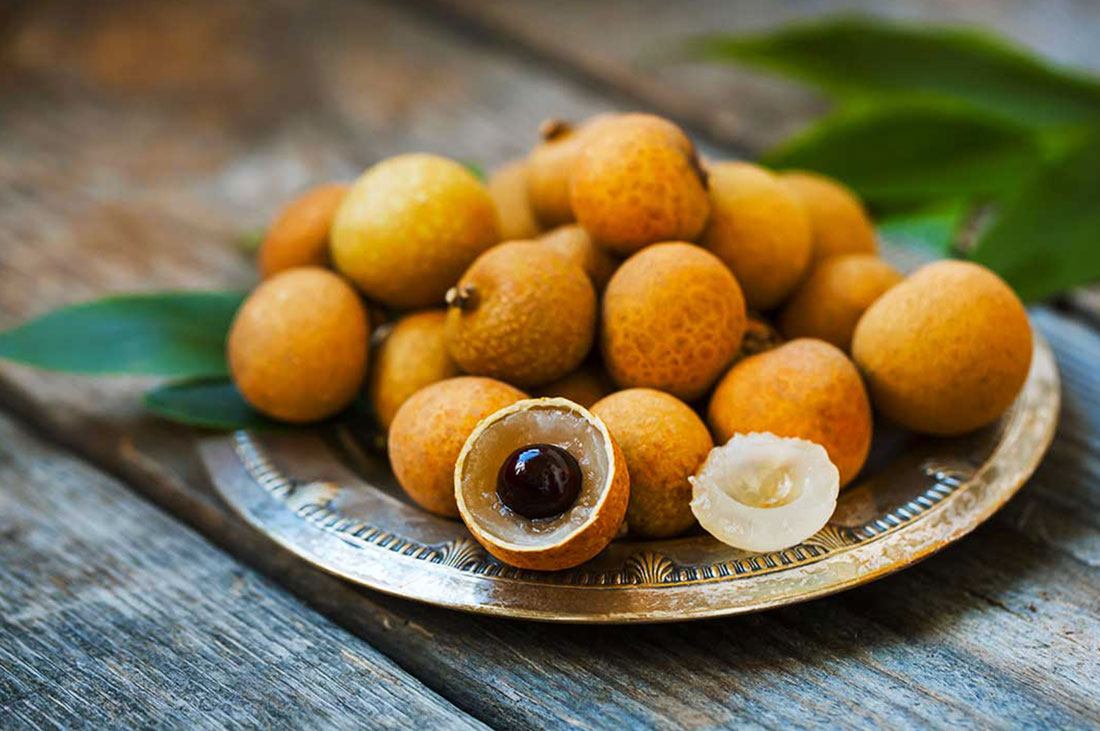Contents
Mango
- Season: April-June
- Price: from 30 baht (~$0.96/€0.85) per kilo
Of course, mango is pretty well-known, but this popular Thai fruit can’t be compared locally to what you get at home. Plump and sweet, mangos bought in Thailand will bring joy to the hearts of any lover of exotic fruit because of their price alone. During the ripe season, in April, mangos cost about 30 baht ($0.96/€0.85) per kilo. Out of season, in winter, they cost around 70 baht ($2.25/€2) per kilo.

Don’t forget that this fruit can be yellow or green depending on the type of mango, but yellow ones are more common. You can tell how ripe they are from their softness, not from the color; they should be soft to the touch.
Many people wonder how best to eat a mango. You should divide it in two, cut out the stone (and nibble off the flesh still stuck to it, naturally) and then chop it up into little segments or little cubes, add to a fruit salad or just eat it as it is.
Papaya
- Season: year-round
- Price: from 20 baht (~$0.64/€0.57) per portion
This exotic fruit looks a bit like a pumpkin in color – and tastes a bit like one, too. No, we’re joking, a papaya is of course much sweeter. You can eat this fruit in a variety of ways: slice it into cubes like the mango or make a smoothie together with banana or pineapple. Papaya contains a whole pile of vitamins and is good for the stomach, so pamper your system as you relax on those Thai beaches.

Papaya are available all year round, and they are sold whole or in slices.
Mangosteen
- Season: March to November
- Price: from 30 baht (~0.96/€0.85) per kilo
This fruit is also known as the mangostan. It is a brownish spherical fruit which looks a bit like an apple when it falls from the tree but has garlic shaped segments inside. Judging by the description, it doesn’t sound like a very attractive prospect, but that’s not the case. It tastes sweet, a bit like a peach, but with citrus overtones, and not for nothing is it known as the Queen of Fruit as it is packed with vitamins. Legend has it that Queen Victoria promised a knighthood to whoever brought her some back.

When selecting mangosteen, pay particular attention to the outer skin. If the skin is hard then it means the fruit is too ripe, but if the skin is soft to the touch, it’s fine to eat. Also, look at the leaves – they should be green. Brown leaves are also a sign that the fruit is overripe. You can eat mangosteen on their own, without any sort of accompaniment – cut it open and enjoy the white bits (and only the white bits).
Longan
- Season: year-round
- Price: from 60 baht ($1.90/€1.70)
What are these bunches of fruit hanging off that little branch? Grapes? No, in Thailand, instead of grapes, they eat longan. It’s a common misconception that longan and lychees are the same thing, but that’s not the case – we’ll say more about lychees later. Try to taste longan before you buy them, otherwise, instead of a bunch of sweet, juicy fruit you might end up with a branch full of sour ones.

To eat the fruit, squeeze it, the light brown skin will split open, and the pulp will come out. Inside are little brown pips – try not to swallow them. They might well make you poorly.
Lychee
- Season: June to October
- Price: from 55 baht ($1.75/€1.56) per kilo
You can tell the difference between longan fruit and lychees by the color of their skin – lychees are reddish-pink and rough to the touch. These fruit taste quite similar and they are both full of vitamin C. Lychees have many other vitamins and other micro-nutrients, too, such as copper and potassium.

You can eat the fruit as it comes, combine with other fruit to make a fruit salad, prepare healthy smoothies, or add it to desserts.
Dragon fruit
- Season: year-round
- Price: from 50 baht (~$1.60/€1.40) per kilo
Another name for this fruit is the pitaya, and it is the subject of many an Instagram photo fest. The fruit is covered in bright pink skin like a dragon’s (whence its name) and inside is a soft white pulp and lots of tiny black pips. Despite its striking appearance, the fruit has quite a bland taste – it is rare to find very sweet ones.

To eat it, just cut it in two and spoon out the pulp – but only after you’ve taken your obligatory photograph. It’s a great low-calorie snack.
Where can I buy fruit in Thailand?
Exotic fruit is to be found everywhere in Thailand, of course, but where is the best place to get hold of it? The easiest way is to head for the closest supermarket (for example Big C – the largest local chain). But why not go the whole hog and be truly local? – buy it from street vendors. It’s real and healthy street food. The fruit is normally stored on ice and the vendor will normally be kind enough to cut it up for you into slices. If you’re spoilt for choice, just point to the brightest, juiciest looking fruit.
Durian
- Season: May to October
- Price: from 60 baht ($1.92/€1.70) per kilo
Of all Thai fruit, the durian is one of the most unusual – you either love it or you hate it with a passion. The durian has a very strong smell – something like rotten onions, so it’s hardly surprising that it has a relatively bad reputation amongst exotic fruit. You aren’t supposed to take it out of Thailand because of this, and certain places won’t allow the fruit at all, such as buses, cafes, hotels, and taxis. Nevertheless, now you’re here it really is worth giving it a try.

Before you eat durian, you should put on some gloves; that way, your hands won’t smell, and you won’t get the little spines in your skin. Cut off the stalk and make deep cuts with a knife along the seams where the bits of the skin join. Then the fruit will open up easily, and you can extract the pulp and enjoy it.
Guava
- Season: year-round
- Price: from 30 baht ($0.96/€0.85) per kilo
A guava is a type of tropical apple, only pudgier looking with a pink pulp inside. It’s also sweet and sour to the taste and is full of vitamins and other healthy nutrients. It has five times more vitamin C than citrus fruits.

How do you eat guava? Best eaten when not quite fully ripe (hard to the touch means they will be tastier), you sprinkle spices on them like ground black pepper, cumin or coriander – even sugar or salt. You can tell how ripe a guava is by its colour – unripe ones are green and as they ripen, they turn yellow.
Jackfruit
- Season: January to May
- Price: from 40 baht ($1.30/€1.16) per kilo
Jackfruit can grow to weigh as much as 30kg! They look like enormous melons. They are also known as breadfruit thanks to their importance nutritionally. A few yellow segments hideaway beneath a thick skin (you’ll only be able to cut into it with a big knife) and they are very filling, so you won’t need to keep much in store.

People with a sweet tooth will especially like jackfruit, which is sweeter than melon and has a strong smell – some even say it tastes like chewing gum. This is one local fruit you are bound to miss when you’re gone.
The variety of fruit available in Thailand can make your head spin. But at the same time, you should try everything at least once. Don’t forget as well that these exotic fruit make great gifts for friends and family, so don’t forget to take some with you when you go home.


